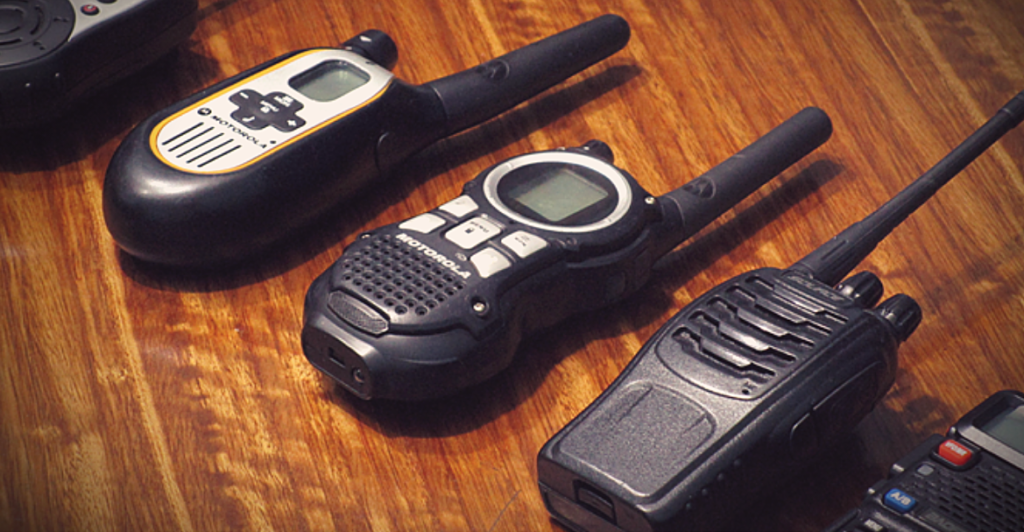By reading this article, you will learn the process of Low frequency SAR testing.
1. What is Low Frequency SAR testing?
2. What kinds of devices use low frequencies?
3. SAR Testing regulation and guidance
4. Laboratory requirements
4.1. Tissue simulating liquid dielectric parameter check
4.2. Test system check
4.3. SAR-measurement
5. Summary
6. References
SAR, Specific Absorption Rate, testing is done for radio transmitting devices that operate above 4MHz frequency and are used closer than 20 cm to the human head or body. SAR is a measure that explains how much radio frequency energy is absorbed by the user’s or bystander’s body or head. Verkotan has the capability to test SAR for radio transmitters transmitting from 13MHz to 6GHz. This covers consumer, medical, healthcare, and military products.
What is Low Frequency SAR testing?
Many consumer products, such as mobile phones, work in radio frequencies above 700MHz. However, there is also a growing range of products working at low radio frequencies between 13MHz and 700MHz. The advantages of using these frequencies are wide coverage, improved voice, data and video services with broadband. From the SAR testing point of view, the low frequency SAR testing has its own demands. It needs special verification antennas, special simulation liquids and phantoms. Verkotan has the capability to do accredited SAR testing also for radio frequencies from 13MHz to 700MHz.
Low frequencies and low frequency SAR testing
ITU (international Telecommunication Union) has determined the low frequency range of radio frequencies to be 20 kHz to 300 kHz. However, in low frequency SAR testing context, low frequency range covers frequencies from 3MHz to 700MHz, which are located at HF (high frequency), VHF (very high frequency) and UHF (Ultra high frequency) radio spectrum. In this article we will not talk about low frequencies in general, but we will go through low frequency SAR testing.
It may be confusing that low frequency SAR testing is performed on frequencies called high, very high and ultra-high. This is because SAR testing is not performed on lower frequency devices than 4MHz. In fact, the lowest SAR testing standard covers frequencies only from 4 MHz upwards. Despite the standard, devices requiring SAR testing typically operate at 13 MHz frequencies or above, such as RFID (radio frequency identification) and NFC (Near Field Communication) systems. Thus, as confusing as it might sound, low frequency SAR testing is performed on high frequency, very high frequency, and ultra-high frequency devices.
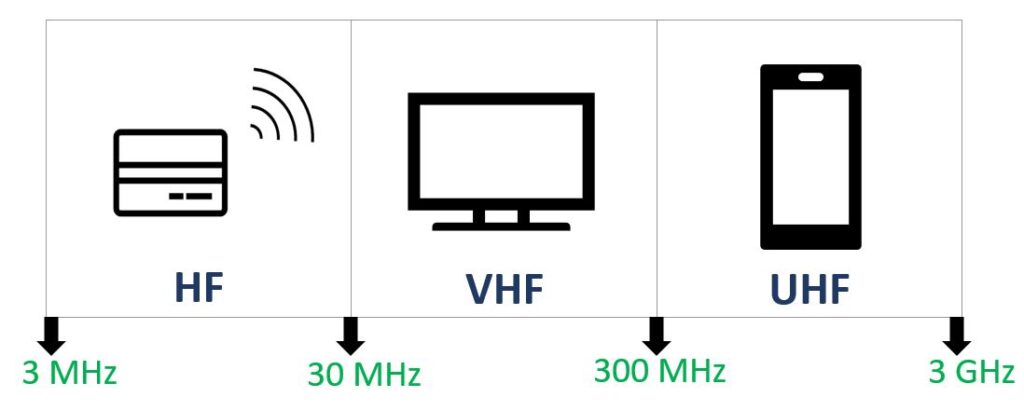
Devices working at HF, VHF and UHF frequencies under 700MHz are for example amateur radios, ppt radios, cordless telephones, walkie-talkies, military devices, and marine radio. Also, two-way land mobile radio systems, industrial remote controls, IoT devices, RFID tags and readers and wireless microphones are working under 700MHz. The advantage for using these frequencies are wide coverage, improved voice, data and video services with broadband. These frequency ranges also support Cat-M and Narrowband-IoT devices.
What kinds of devices use low frequencies?
Picture below demonstrates different types of devices that work between 3 kHz and 300 GHz frequencies and have wavelengths between 100 km and 1 mm. In this article, we will introduce HF, VHF, UHF and 450 MHz alliance in more detail.
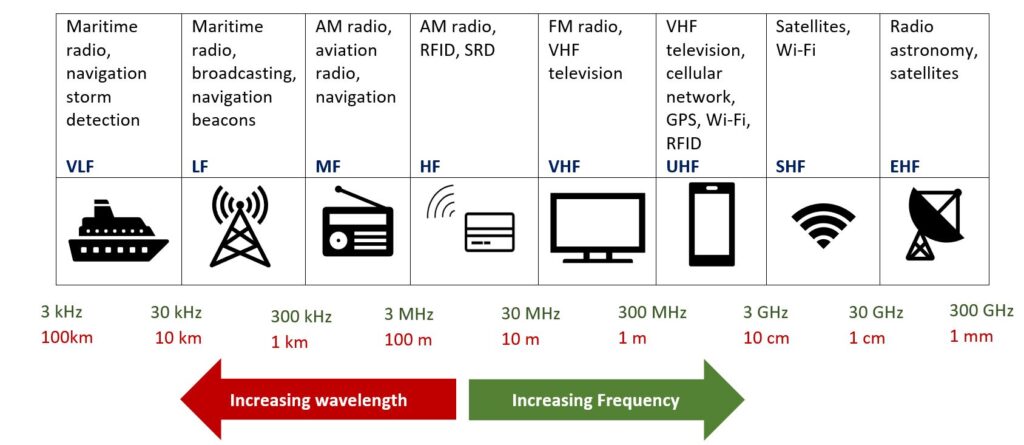
High Frequency
HF covers frequencies from 3 MHz to 30 MHz. Example of a technology working in HF, 13.56 MHz frequency, is RFID. There are RFID readers that are transmitting on 13.56 MHz frequency in order to read RFID tags. RFID tags used at 13.56 MHz frequency, called HF tags, are quite inexpensive, making the utilization of the frequency tags cost effective. The uses of the RFID tags can be for example access control, patient tracking and credit cards. HF tags are currently the most wildly used tags.
Active RF components, like RF readers, need to have RF exposure evaluation, which, depending on the device and transmission, is SAR testing or other methods of evaluation.
Very High Frequency and Ultra High Frequency
VHF covers frequencies from 30 MHz to 300 MHz and low-band UHF covers frequencies from 300 MHz to 900 MHz. UHF band is shared between low-band UHF and high-band UHF. High-band UHF starts from 900 MHz. In practice, the operating range is divided into smaller sections, such as 136-174 MHz and 400-512 MHz, rather than the whole bandwidth in one device.
As an example, amateur radio uses universally 50-54MHz and 144-146MHz frequencies. Other frequency allocations can vary country by country. For example,
- Maritime Mobiles are using fixed 130-135.7MHz frequency in Australia.
- In United States, Marine radio is using 156-158MHz and Maritime mobile in 216-222MHz.
- Walkie-talkies can operate on 136 MHz to 900 MHz frequency range.
The lower the frequency the walkie-talkie uses, the longer the radio waves are. Then the device is able to cover longer distances with less output power, which works well outdoors. For indoor use, the higher frequency, such as 400-512MHz, is better as shorter waves travel through obstacles better.

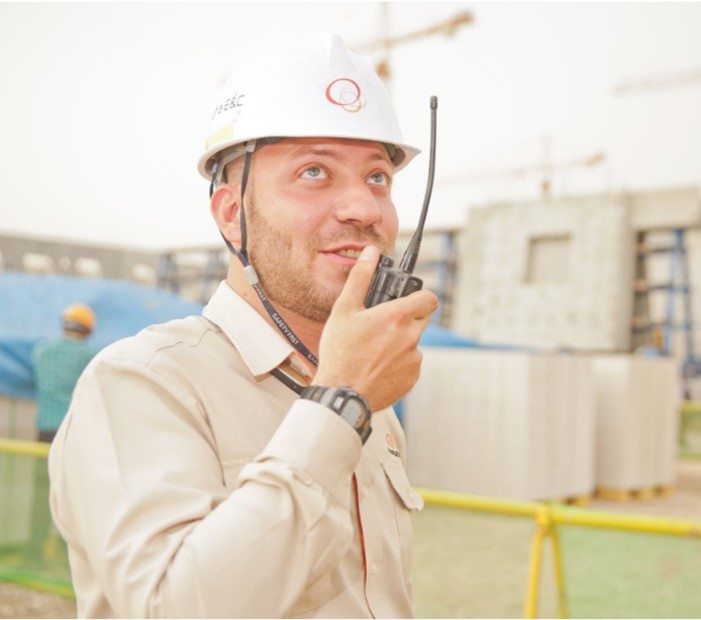
UHF and 450MHz alliance
The task of the 450MHz alliance is to promote allocation of the 450 MHz spectrum worldwide. According the 450MHz alliance prediction, the evolvement towards LTE of the spectrum in 380 MHz to 512 MHz is expected to increase. Specially NB-IoT and LTE-M usage in 450MHz band is expected to grow. To reinforce the usage of 450 MHz band, the 450MHz alliance has been established. The 450MHz alliance members consists of wireless carriers and equipment manufacturers.
The devices at this frequency range consist, for instance, of:
- Handheld mobiles
- Routers
- Modules
- Utility meters
- Security monitoring
- Location tracking
- Medical metering
- Wearable devices
LTE bands operating in 400 range are LTE 31, 71, 72. LTE Bands 87 and 88 (410-430 MHz) were accepted by 3GPP in June, 2019.
SAR Testing regulation and guidance
Accredited SAR testing is guided by standards and regulations set by the authorities of the country where the product is going to be sold and used. Standards, such as EN 50566 product standard, guide how to demonstrate the compliance of wireless communication devices with the basic restrictions and exposure limit values related to human exposure to electromagnetic fields in the frequency range from 30 MHz to 6 GHz for EU. For US markets, 447498 D01 General RF Exposure Guidance v06, state the requirements for the SAR testing. However, in 2021, the FCC published an update to the KDB Publication 447498 D01. Read more how this affects from our Changes in RF exposure guidance -news.
Changes in RF exposure guidance
In October 2020, IEC published an updated combination of two standards; IEC/IEEE 62209-1528: Measurement procedure for the assessment of specific absorption rate of human exposure to radio frequency fields from hand-held and body-mounted wireless communication devices – Part 1528: Human models, instrumentation, and procedures (Frequency range of 4 MHz to 10 GHz). As stated in that standard, SAR is a valid method of evaluating RF exposure starting from 4MHz. Previously the lowest applicable frequency was 30MHz as per IEC 62209-1 and 300MHz as per IEEE 1528. The extension of the applicability range to 4MHz means that more products can be assessed for compliance by SAR testing.
The SAR value limits are set by the authorities. The product that is tested must be less than or equal to the limit in order to be compliant. The SAR limit varies in different countries, being SAR10g: 2.0W/kg for EU and SAR1g: 1.6W/kg for US and Canada.
Laboratory requirements
From the SAR testing point of view, lower frequency SAR testing has its own demands; special verification antennas, special simulation liquids and phantoms are required. The accredited SAR testing requires the test system to be calibrated and validated. The testing consists of following parts;
- Tissue simulating liquid dielectric parameter check
- Test system check
- SAR measurement
1. Tissue simulating liquid dielectric parameter check
For SAR testing, the phantoms are filled with tissue simulating liquid that has similar electric parameters of either head tissue or muscle tissue. The conductivity and permittivity of the tissue are dependent on the frequency. Similarly, the simulant liquid has electric parameters that alter with frequency. The conductivity and the permittivity of the tissue simulant are measured prior the SAR testing. The testing of the dielectric parameters is done by using Dielectric Assessment Kit, DAK and vector network analyzer. If the dielectric parameters are not within specified limits of the target values specified in standards, the liquid is adjusted by adding water or other ingredients to meet the required specifications.
In Verkotan we have the capability to produce tissue simulating liquids from 12MHz to 6GHz. We offer head simulating liquids, body tissue simulating liquids, simulants for non-standard testing, and simulants for research purposes.
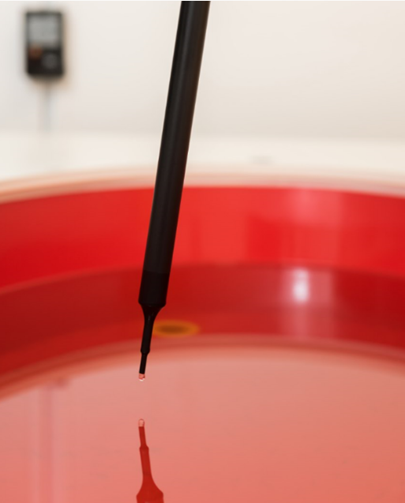
2. Test system check
The system check is required to verify the measurement setup before the SAR testing of the device can be done. The purpose of the system check is verifying that a SAR measurement system operates within its specifications at the test frequencies. With system check the measurement system is detected for not having any test system component failures or drifts or any unfavorable conditions in environment, such as RF interference.
The system check is done by feeding known signal to a dipole antenna or another standardized antenna placed below the phantom and by measuring the SAR value. The measured SAR value is compared to numerical target values and it should not deviate from the target value by more than ±10%.
The verification of the measurement system is done with dipoles up to 300MHz and with confined loop antennas (CLA) below 300MHz.
As the radio frequency gets lower the wavelength gets longer. For example, the wavelengths are at 1800MHz 0.17m, 700MHz is 0.43m, at 450 MHz is 0.67m, at 150MHz is 2.0m and at 30MHz is 10.0m.
Verification antennas
The length of the dipole is in relation to the frequency: the lower the frequency, the longer the dipole. The length of the dipole would be very long at frequencies below 300MHz. Thus, the CLA antennas are more practical in day-to-day use for low frequencies. The structure of the dipole is symmetrical with λ/4 balun and resonant loop antenna for CLA antennas.
In Verkotan we have 13MHz, 30 MHz, 64 MHz, 128 MHz, 150 MHz, 220 MHz CLA antennas. We also have dipoles for 300 MHz and 450 MHz, covering frequencies from 13MHz to 550MHz for which we can perform accredited SAR testing for products working in MF, VF and UF ranges. Verkotan has also the capability to do accredited SAR testing from 1350MHz to 5860MHz frequency range.
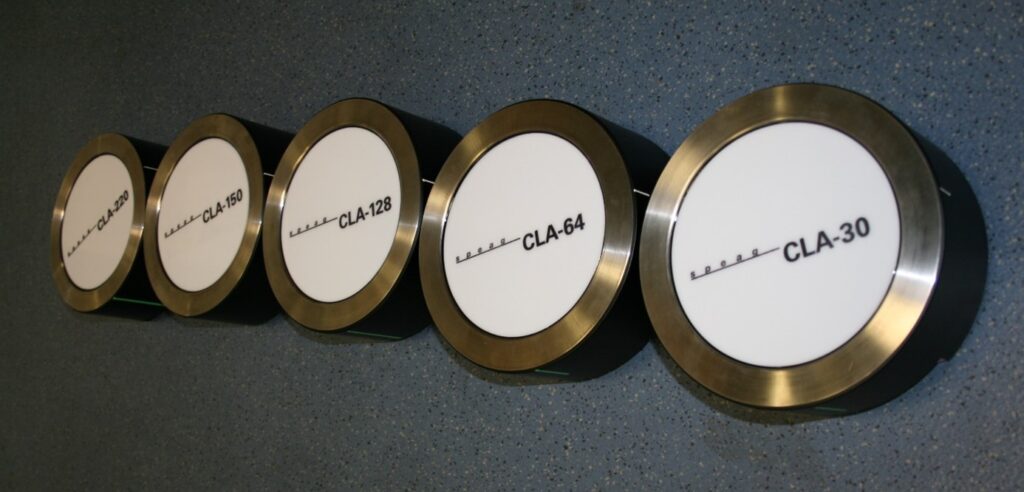
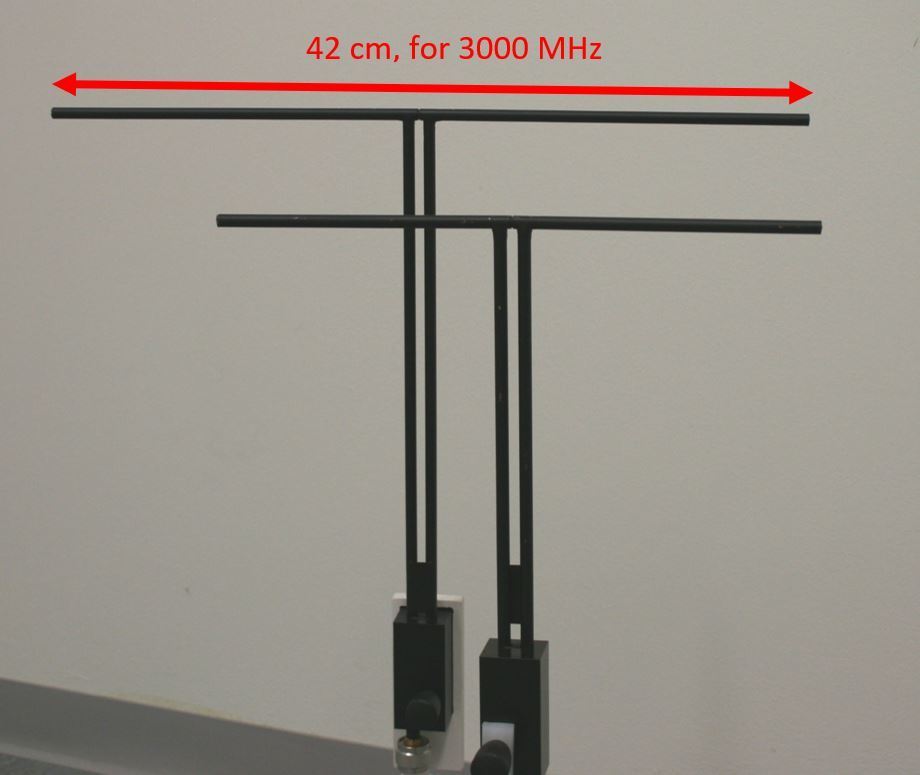
Phantoms for Low frequency SAR testing
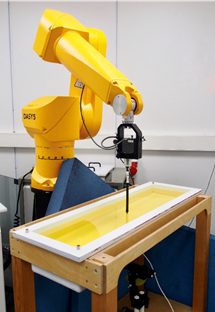
The low frequencies, 13 MHz to 700 MHz, and long wavelengths set also special specifications to phantom’s size that can be used for testing. The requirement for the flat phantom size is that the phantom’s flat bottom must fit an ellipse with length 0,6 λ and width 0,4 λ, where λ is the wavelength in air. For body SAR testing Verkotan have three different phantoms that can be used at these frequencies they are: ELI; elliptical phantom, Base station phantom adult; BSTP-A and Base station phantom child; BSTP-C. For against the head testing, the SAM phantom is used.
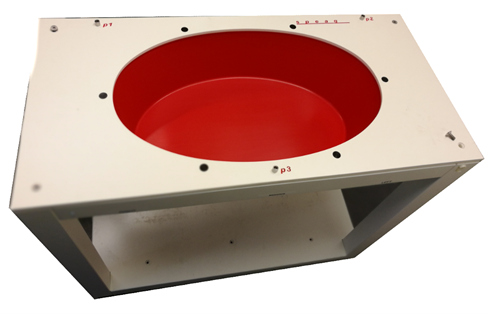
3. SAR measurement
SAR testing positions for a product depend on the product and how it is used while the transmission is on. If the product can be used next to the head, then head SAR is needed.
Head SAR
Head SAR is measured by placing the product under the SAM phantom. SAM (Specific Anthropomorphic Mannequin) phantom is a standardized phantom. The phantom has right and left sides of the head. Testing is done in two standardized positions. Cheek position, which has device touching phantom at the ear and cheek and tilt position, which is a 15° tilt away from the cheek while the device touches ear. For compliance, the tested SAR results of the device has to meet the exposure limits set by authorities.
Body SAR
A device that can transmit within 20cm of the body, such as lone worker alarms, body SAR needs to be tested. The body SAR is tested by placing the device under the flat phantom with specified separation distance from the phantom. There are requirements for the flat phantom size for the frequencies from 150 MHz to 800 MHz. The phantom flat bottom can have any shape that fits an ellipse with length 0,6 λ and width 0,4 λ, where λ0 is the wavelength in air. So, for example 450MHz frequency has wavelength of 0.67m thus the flat phantom needed for testing must fit the ellipse of length 0,4m and width 0,27m. SAR testing 450MHz body SAR can be done with ELI or Base station phantom adult.
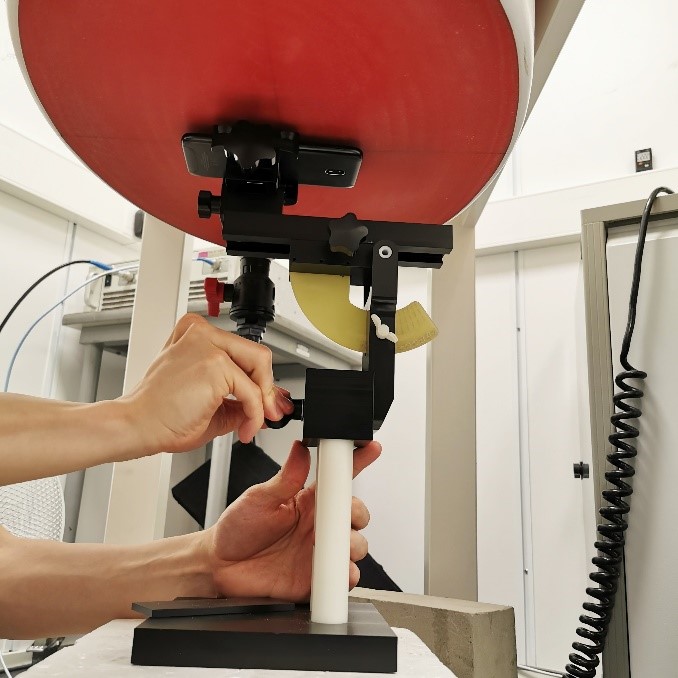
Devices that are used in the front of the face, like push to talk devices, need to be tested for that configuration. The testing is done by placing the device under the flat phantom with 25mm separation between the device and the phantom. If the intended use of the device is in the hand, then limb SAR is tested. For the testing, the device is placed in touch with the phantom and the testing is done for all six sides of the device.
Summary
There is a growing number of different products that need low frequency SAR testing, frequency range is then between 13MHz and 700MHz. The advantage for using these frequencies are wide coverage, improved voice, data and video services with broadband. From the SAR testing point of view, the low frequency SAR testing has its own demands. It needs special verification antennas, special simulation liquids and phantoms.
To sum up the testing process:
- Tissue simulating liquid dielectric parameter check
- Test system check
- SAR measurement
We can help you to get your products to market fast with the right testing and evaluation of your device’s performance. From us, you will get the measurement results for your needs!
Continue reading about our SAR testing services if you want to know what we can offer you. Also, request a Quote for SAR Testing if your device needs SAR testing.
References
- https://www.theseus.fi/bitstream/handle/10024/160959/Kinnunen_Ilari.pdf?sequence=2&isAllowed=y
- https://apps.fcc.gov/kdb/GetAttachment.html?id=ARcyvK1h4uoKj8FLtKtPkQ%3D%3D&desc=248227%20D01%20802%2011%20Wi-Fi%20SAR%20v02r02&tracking_number=28238
- https://www.pxfuel.com/en/search?q=walkie-talkie
- DocsRoom – European Commission (europa.eu)
- IEC – TC 106 Dashboard > Projects: Work programme, Publications, Maintenance cycle, Project files, TC/SC in figures
- https://www.highlandwireless.com/the-differences-between-uhf-and-vhf-radio-frequencies/
Contact us if you have any questions, we are happy to help you!
